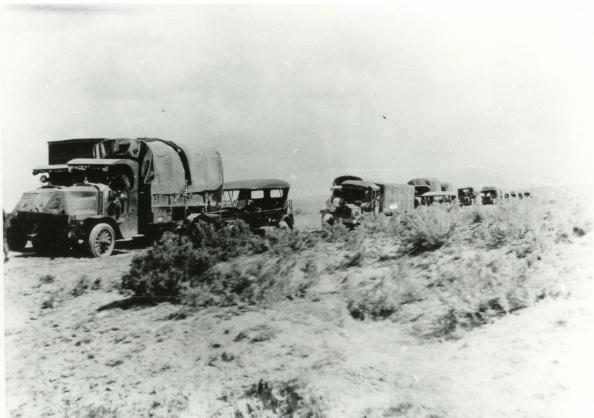Most people today find the thought of making the long journey from one side of the United States to the other by car a daunting prospect, but in an era when motorized transport was still a fairly new idea the Transcontinental Motor Convoys of 1919 and 1920 were truly epic undertakings. Not only were the vehicles involved prone to regular breakdown but the roads themselves were also often unpaved and sometimes near to impassable for great stretches. It was in fact partly to emphasize the importance of improving the nation’s highways that inspired the convoys in the first place. Other aims were to test the mobility of motorized forces over rough terrain, to demonstrate the usefulness of motor vehicles for military purposes, to test how well different vehicles performed, and to promote recruitment to the Transport Corps.
A small number of intrepid individuals – not to mention a film crew who made a record of their four-month journey in 1915 – had already completed transcontinental trips in earlier years, but the massed convoys of 1919 and 1920 were different matters altogether. Organized by the US Army’s Motor Transport Corps, the two convoys comprised “truck trains” of dozens of trucks and other vehicles, many of them surplus vehicles churned out by factories for use in World War I.
The 1919 expedition consisted of 81 such vehicles, ranging from heavy trucks and tractors to staff cars, ambulances and motorcycles. It is said there was even a light tank mounted on a flatbed trailer. The vehicles were manned by 258 enlisted men and 24 officers, all under the watchful eyes of a team of staff observation officers from the War Department whose numbers included a young Lieutenant Colonel Dwight D. Eisenhower of the Tank Corps. The party also included engineers, machinists, mess units, a medical team, a recruiting officer and a civilian band. This small army set off from Washington, D.C. at one pm on 7 July 1919 with the aim of getting as many of the vehicles as possible to journey’s end at San Francisco, 3251 miles distant. They were to follow the planned route of the unfinished Lincoln Highway until they reached Oakland, California, from where the trucks would be ferried to San Francisco itself.
Many of the drivers had little or no training at driving motorized vehicles. “Most colored the air with expressions in starting and stopping that indicated a longer association with teams of horses than with internal combustion engines,” Eisenhower later confided. Not that the officers had much more experience themselves at keeping everything moving at a good pace. The first 46 miles took all of seven and a half hours to complete.
Progress in the early stages was reasonably good, but things got worse as the quality of the roads deteriorated the further west they got, particularly once they reached Nebraska. Vehicles broke down on dirt tracks, got stuck in mud or quicksand, or came off the road completely. On one memorable day no less than 25 trucks all skidded into a ditch. Sometimes there was no alternative but to get out and push. Water ran short while they were in the Salt Lake Deserts and had to be rationed, with each man getting just one cup to last from supper and through the night. Many men suffered injuries as a result of accidents. Dozens of the wooden bridges the convoy crossed had to be repaired after the vehicles had passed over, due to damage from the weight of the trucks.
All along the way, however, ecstatic crowds turned out to welcome these heroes as they battled with exhaustion and a host of other tribulations. To keep spirits up between stops Eisenhower and a friend staged practical jokes on the junior officers, even staging fake knife fights and a Wild West shoot-out.
By the time the convoy eventually reached its destination, six days overdue, it had logged 230 incidents on the road. Nine vehicles had dropped out along the way and 21 men had been unable to complete the trip due to injuries sustained. The whole thing had taken 62 days at an average speed of around 6 mph, which is little faster than walking, though speeds of up to 32 mph had been attained at various points.
The 1920 convoy left Washington, D.C. on 14 June 1920 for San Diego, California. It was on a slightly less ambitious scale than the first convoy, with just 50 vehicles manned by 160 enlisted men under 32 officers, and it got off to a good start, until it reached Tennessee. There, flooding created an additional hazard to those encountered by the first expedition. Having struggled through the waters of the Mississipi region, the convoy then floundered in the shifting desert sands of Arizona before finally making a triumphal entry into San Diego on 2 October, no less than 111 days after it had begun. Once there the vehicles were handed over for the use of California’s public services.
So how successful were the two convoys in meeting their goals? The Army certainly learned a lot in terms of logistics and about the strengths and weaknesses of its vehicles, though recruitment to the Transport Corps did not rise appreciably during the course of the two trips. Millions of civilians, however, came out to see the “truck trains” go by, so the ventures were big public relations successes at least.
More importantly, public attention was attracted to the push to improve the nation’s major road routes. This proved insufficient in the short run to persuade the federal government to assume responsibility for a national highway system, but in the longer run it did serve to promote a change in policy. In the 1950s it was Eisenhower, now President, who was to draw on his experiences in the 1919 convoy to promote the building of a modern system of interstate highways, with the federal government meeting 90 per cent of the cost.

